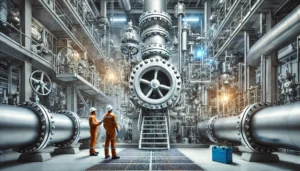People often think that the only reason for installing pipe insulation is to conserve heat, but there is so much more to it than simply maintaining temperature. Insulation helps enhance energy efficiency, safety, and environmental control, and noise pollution. Be it in heavy process industries, residential buildings, or even infrastructure projects, the particular choice of the insulation material and design would most likely prevail in both performance and cost effectiveness.
This post discusses the different aspects of pipe insulation such as materials and applications, and now and then phenomena occurring in the industry.
Need of Pipe Insulation
Controlling Temperature (Thermal Control)
The main aim of using pipe insulation would be to control temperature. For hot pipes, energy losses are reduced by insulation, achieving efficiency and allowing the pipe’s user to maintain the desired temperature of the fluid traveling through it. Condensation which results in corrosion or weaker performance may be avoided by insulating cold pipes. For example, pipes of thermal power plants have steam inside them and the pipes get very hot. So, to prevent loss of energy and burn injuries, the pipes get insulated.
Acoustic Insulation
Any noise due to the motion of water or vibration within the pipeline may disrupt functioning of operations. Such noise may be distracting and therefore, good acoustic insulation is required. Talking of relationships of tension absorption in noise is significant; again states that it is important in residential or business construction where lies the focus on intensity control, besides, also in other industries where a considerable noise is formed by high-speed flow of liquid.
Safety
Insulated pipes aid in protecting workers as well as equipment from high or low surface temperatures. For instance, hot pipes can cause burn injuries and cold pipes frosts. So, insulation does the work of separating heat which enhances safety in the workplace and damages health standard requirements.
Energy Efficiency
Because energy is often lost through uninsulated pipes, heat requires extra energy to be created, resulting in carbon footprints. In industries like oil and gas or chemical which uses a lot of energy, costs incurred can be greatly minimalized in thoroughly insulated piping systems.
Environmental Protection
Pipes that are cold are highly susceptible to heating and therefore condensation. CUi (corrosion under insulation) which is largely present in warm setting like in equator hot weather is avoided. Increase insulation of pipes that are placed outside protects from climatic temperature changes and harsh weather and external temperature fluctuations.
Piping Thermal Insulation Materials
Fibreglass
Fibreglass as an insulation system is very much widely used thermal insulation covering due to its relatively cheap cost and very good thermal performance. It finds applications in both hot and cold piping systems and is sometimes supplied with Aluminium or PVC jacketing. However, fibreglass cannot be used in very extreme temperatures or very corrosive environments.
Polyurethane Foam
Polyurethane foam (PUF) can be classed as an insulator due to its cellular structure and ideal for cold pipelines like those for refrigeration and cryogenic systems because of its high R-value. Its lightweight and moisture resistance features are advantageous in industrial and commercial sections.
Mineral Wool
Mineral Wool is often manufactured from natural or synthetic fibers and are well known to be durable against high temperatures and fires. Depending on the need, including acoustic panels, fire-rated partitions, or walls and ceilings. It is also widely used for high-temperature pipes, including in steam pipelines.
Elastomeric Foam
Elastomeric foam is a durable elastic material that has great tensile range and great thermal and moisture efficiency properties. It finds its application in piping systems and HVAC systems that are outside.
Calcium Silicate
Calcium silicate is said to be a rigid material that is commonly used on high-temperature piping as it has good thermal and fire insulating properties. Often it is selected for use in power plants and chemical and refining plants.
Traditions of Pipe Insulation
Services That Go Green
Insulation material that’s eco-conscious is in great demand. Low-emission and recyclable materials such as bio-based foams and recycled mineral wool have really started to trend for industries that are wanting to reduce their carbon footprint.
Greater Efficiency
Aerogels, nano-insulation, and various other new insulation materials, are changing the realm of thermal efficiency. Without sacrificing efficiency, thickness is reduced and more room can be made for pipe installations.
Pipe Insulation Style
New age pipe insulation automatically has additional features such as acoustic and safety concerns woven into a singular mat… This means that time and costs for installations were both minimized, while boosting system performance in its entirety.
New Age Thermostat System
Temperature change will be tracked in real time as new sensors are implanted in the insulation system and can help in tracking the efficiency of the insulation wall, these new systems allow for better observations ensuring less energy shift.
Various Other Applications Of Insulation Pipes
Industrial Settings: Refineries, power plants and chem facilities, Pipe Insulation aids in the functioning, energy minimisation and optimised security.
Air Conditioning: In heating ventilation systems, including air conditioning insulation, condensation is prevented, which curbs excessive energy usage.
Refrigeration: A vital factor for refrigeration and LNG pipes heat loss and condensation are nullified due to insulation.
Residential and Commercial Buildings: Reticulation systems that use insulated piping within the structures assist in minimizing noise while keeping the water temperature stable allowing comfort to be enjoyed.
Conclusion
Insulating pipes is much more than limiting heat loss and heat gains; it is a remedy that helps to reduce risks, increase efficacy and prolong the lifetime of the building fabric. Depending on the types of the insulation materials used and knowledge about the insulation market trends, such as lifecycle costs, the operators of industries and buildings optimally design the systems with the desired performance and economical goals in mind.
Pipe Insulation is witnessing advancements like advanced materials, integrated systems, and digital monitoring making the pipe insulation future seem bright. And if we are looking for the future-insight, pipe insulation is not only a part of regulating the temperature of the in-service pipes. Rather, it is one of the requirements of the modern construction which enhances safety, efficacy and protection of the environment in many applications.










